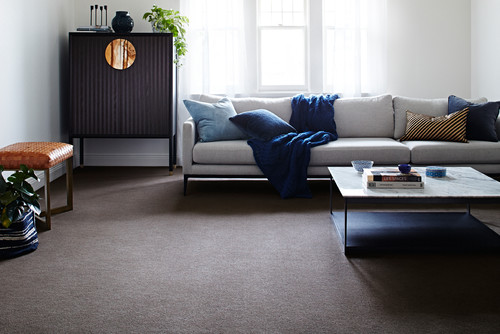Flooding within your house is among the worst scenarios for any homeowner. Water and moisture is the enemy of carpets and should be taken care of immediately.
If you don’t get rid of the moisture in your carpet quickly, it can lead to the growth of mold, mildew, and other microorganisms that can cause disgusting odors.

Photo by Godfrey Hirst – Look for living room pictures
So, when faced with flood damaged carpeting and rugs, your options will depend on the source of flooding.
Determine what Kind of Water Caused the Damage
If the water is from a toilet, or sewage line, then this water is named “black water.”
Solution: You should immediately discard your carpet. It will be an expensive process, but there are too many bacteria lurking in that type of water that would fester and create many more health problems for occupants. Except for valuable rugs, the time and expense of professional cleaning generally is not worth the effort or the health risk.
If the water is from a main water line, then you can consider yourself lucky. This can be repaired. A wall-to-wall carpet soaked by clean rainwater can also, be salvaged.
Cleaning and Drying the Carpet
Carpet drying is the primary goal. You want to remove all the water from the carpet. However, if the carpet has been soaked for more than 24 hours, replace it. If the carpet has been wet for less than 24 hours, you may clean it or have professional cleaners come in to address the need. Check with your insurance company to be sure you respond in a manner that will be covered.
If your carpet is soaked because of water spilled, cracked water pipes or a leaky roof, there are some things you can do to prevent further damage. You will need to fix those problems first.
Depending on depth, you can remove the water from carpet in two ways, either with a shop-vacuum or a pump.
Your best bet is to rent a carpet cleaner, such as a wet/dry vacuum or a steam cleaner. The wet/dry vacuum uses cleaning solutions that are injected into the carpet and then sucks up the solution and moisture from the carpet. The steam cleaner quickly dries, cleanses and sanitizes the rug.
To remove the remaining moisture, you’ll need to circulate as much air as possible, by opening doors and windows, and bringing in fans or other similar air moving devices.
Carpet Stain Removal – Useful Tips and Creative Ideas (howtobuildahouseblog.com)
Drying the Carpet
This is the most important part. Direct as many fans as you can at the damage spots (most professionals recommend industrial fans set on high), open windows; get a dehumidifier, whatever it takes.
Dab the dry towels on the blanket to help soak up some of the excess moisture. This is the longer route, but it is important to remove as much moisture as you can, as quickly as you can to prevent mildew and mold. The first 12 hours are the most important part of this process – this is the time frame in which mold can grow in your carpet.
Then if you’re able to, you can elevate the wet parts of the carpet and remove the carpet padding to allow it to dry out.
Getting Rid of Odors
Mold and mildew aren’t the only issues involved with water damaged carpets. A foul smelling odor can also raise its stinky head.
When the carpet is thoroughly dry, you should vacuum the area. Shampoo and repeat the drying process. Keep in mind that most modern carpeting is made of nylon and should not be treated with bleach. When dry, vacuum again.
Once you’re sure that you’ve removed all of the liquid possible, you can use an enzyme odor remover to treat the carpet. In some cases it is enough to use carpet deodorizers or even air fresheners in the area, such as Febreze.
You can reduce also, a stinky smell with baking soda.
Sprinkle baking soda over the carpet, working it in with a broom or sponge mop.
Leave the baking soda treatment on overnight.
Vacuum the baking soda out.


